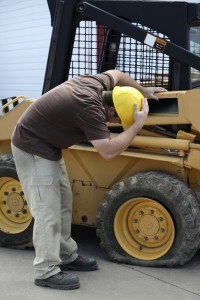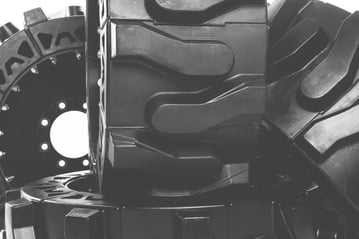Bobcat tires are stressed. This can lead to a variety of problems that can be easily overcome by purchasing the correct tire for your application. In this post, we'll look over some factors to consider when purchasing your next set of Bobcat tires.
Problem #1 - Flat Tires
If your Bobcat drives in an environment that makes punctures easy, flat tires can be a very expensive problem. Construction sites, waste disposal stations, and similar areas can be filled with debris that goes unseen by the driver. This can lead to punctures. Luckily, there are a couple of solutions that can reduce, or eliminate puncture damage to your Bobcat tires.
Solid tires are the best way to do so. Although they are a little more expensive than their air-filled counterparts, solid tires will more than make up for the cost when you account for how much you would otherwise spend replacing punctured tires.
You could also fill your Bobcat tires with foam. Foam-filled tires will help reduce the damage punctures do to a tire but come with some problems of their own. They are heavier than solid tires and add additional stress to the drivetrain. Foam-filled tires are also more difficult to service than their solid or air-filled counterparts.
.png?width=378&name=Problems%20and%20Solutions%20for%20Bobcat%20Tires%20(1).png)
Both solid and foam-filled tires also have the added advantage of never dealing with a broken bead from an air-filled Bobcat tire again. This means you can traverse uneven ground and climb objects at an angle without worrying about side impact damage.
Problem #2 - Bouncy Ride
Air-filled tires can provide a pleasant, smooth ride. But air-filled tires bounce a lot. If your terrain requires putting a lot of shock on your bobcat tires, your operators may bounce all over the place.
Solid tires can significantly reduce the bounce, but cheaper variants may result in a rough ride. High-quality solid tires, however, will be made of ideal materials to provide a smooth ride for the operator without bouncing them around excessively.
Problem #3 - Poor Quality and Short Wear Life
There can be a variety of conditions that lead to a shorter life than you want for your Bobcat tires. In this section, we'll look at a few and discuss some things to look for in a tire. This will mitigate the problems those conditions cause.
If your machine operates on asphalt, concrete or other difficult surfaces the majority of the time, it will experience significantly more abrasion and wear than tires on softer surfaces are asked to endure. Hard surfaces Bobcat tires are specially designed to contact the ground. By doing so, the machine's weight is spread out over a larger area and wear from abrasion is greatly reduced.
In addition to rough surface wear, cheaper tires are more susceptible to wear and tear. Hard surface Bobcat tires are clearly designed to minimize tire wear, as we've already mentioned. But they may not always fit the terrain your Bobcat tires are expected to operate on.

Solid tires also have longer wear life than air-filled tires in this case. This is because of the thicker, higher quality rubber solid tires are made of.
Segmented tires also offer great quality and wear life benefits. Because segments of the tire can be replaced individually, the need to replace the entire tire when just one portion has become damaged is eliminated.
Since a tire problem is isolated to one area, time and money can be saved by not removing and replacing the whole tire.
Conclusion
We hope that this post has given you some insight into how to solve some common Bobcat tire problems. Check out Evolution Wheel's product range as we have a variety of tires that are suitable for all types of demanding applications
To learn more about Bobcat tires visit the EWRS-AT Series from Evolution Wheel.

